When I wrote about Masahiro Tanaka over the winter, my analysis was limited to the piecemeal footage that could be found across the interwebs, which led to a lot of caveats about what we could expect of his performance in the majors. There were many reasons for caution when projecting the state-side translation of his skill set, ranging from his workloads and pitch selection to his mechanics and statistical profile. With a trio of big-league starts now under his belt, we have a much clearer picture of his talent.
Tanaka has enjoyed a smooth acclimation to the major leagues thus far, and his early-season success is not entirely a surprise. My expectation was that he would perform well on his first tour of the league but that he could struggle once teams adjusted to his gameplan, and that he would likely have an adjustment period before reaching his theoretical ceiling. The early indications this month have been very encouraging, with positive implications for his performance going forward. Let's take a look at Tanaka's stats, stuff, and mechanics over his first couple weeks of big-league play.
|
K % |
BB % |
H % |
HR % |
|||
|
3 |
22.0 |
1.97 |
33.7% |
2.4% |
18.1% |
2.4% |
Tanaka's first three starts have been an unquestioned triumph, with a 1.97 ERA and a strikeout-to-walk ratio of 28-to-2 in 22 innings of work. His utter dominance of the Cubs on Wednesday can be partially attributed to the weak lineup on Chicago's north side, but his strong performance against the hearty offenses of Baltimore and Toronto are not so easily cast aside. He has lasted seven full innings or more in all three outings and has recorded more than a strikeout per inning in each start. From the “Three True Outcomes” standpoint, the only knocks against his stat-line are the pair of walks and two homers allowed. One of those home runs came against the first batter Tanaka faced in his big-league career, when he left a 1-1 pitch above the belt and out over the plate that Melky Cabrera launched into the seats.

The right-hander brings a varied arsenal to the mound, and though 90 percent of his pitches fall within the categories of fastball-slider-split, he offers multiple fastball variations in addition to the occasional slow curve. The fastball velocity typically runs in the 91-93 mph range, though he can reach back for 94-95 on his four-seamer or take something off to add tail with his sinker. On average, the sinker veers four inches off of his four-seam fastball trajectory when looking at the horizontal movement and drops an additional 4.4 inches in the vertical plane. Tanaka leans on the sinker when behind in the count, adding movement in order to avoid hard contact in fastball counts. The pitch is particularly impressive when he peppers the floor of the strike zone.

Tanaka uses the slider more often against right-handed hitters, but he has shown a willingness to throw it in any count. The pitch has tight, vertical break that keeps it near the bottom of the zone when he finds his ideal release point, but he had a tendency to elevate the slider in his first three outings, leaving him vulnerable to deep flies. The slow curve runs in the low 70s, and Tanaka typically uses it in the first pitch of an at-bat to get a gimme strike against surprised hitters who are sitting on heat.


Tanaka’s most feared weapon is his splitter, a mid-80s offering with late drop that features devastating arm-side run at its peak. Tanaka has rarely thrown the split early in an at-bat, but it is his pet pitch when he’s ahead in the count, and batters must keep it in the back of their minds once they have two strikes. The strategy allows hitters a chance to focus on the fastball—which Tanaka often fires on the lower shelf of the strike zone—before the splitter shows up to drop under their bats. His splitter, slider, and various fastballs all leave the hand with the same trajectory and feature late movement, giving batters little chance to identify the pitch type before initiating a swing.


Tanaka has jumped ahead early in counts this season, delivering first-pitch strikes to 65 percent of the batters he’s faced. Many of these early strikes are misfires, but he earns strike one due to the movement of his stuff as well as his tendency to find the strike zone on the pitches where his timing is off track. Therefore, his low walk rate is deceptive, giving the impression of elite pitch location despite his tendency to elevate breaking pitches and miss arm-side with his fastball. Regardless, Tanaka's ability to hit catcher targets has been better than anticipated, and the mechanical underpinnings of that command offer a hint of optimism that he can keep up the good work.
Mechanics Report Card
|
Category |
2013 |
April 2014 |
|
Balance |
45 |
50 |
|
Momentum |
55 |
55 |
|
Torque |
55 |
55 |
|
Posture |
40 |
50 |
|
Release Distance |
55 |
60 |
|
Repetition |
N/A |
60 |
|
Overall |
C |
B- |
For an explanation of the grading system for pitching mechanics, please consult this pair of articles.
I was skeptical about Tanaka’s mechanics when reviewing the footage from his previous body of work, but his delivery thus far this season has featured improvements in a couple of key areas. For starters, he has essentially eliminated the NPB pause from his delivery, and though his approach to max leg lift is relatively slow, he does have a smooth transition into second gear that features a solid burst to the plate. The net score for momentum may not have changed, but he has smoothed out the transition between gears for a more repeatable motion. The pause was much more pronounced at the WBC last season, but he had minimized the mid-momentum halt by the Japan series in November, and there is rarely any sign of it in 2014. From the windup, Tanaka performs the same samba-style of side-step that Daisuke Matsuzaka made famous (though not as exaggerated) before initiating the lift phase of his delivery.

In theory, ditching the pause allows Tanaka to find a more consistent timing pattern between windup and stretch, but he still employs drastically different deliveries with runners on versus the bases empty. Out of the stretch, he has a much quicker pace to the plate, and his balance undergoes an exaggerated drop-and-drive in which his backside collapses and his center-of-gravity suddenly sinks. He uses a drop from the windup as well, but its magnitude is greatly reduced with the bases empty. In effect, his balance and momentum grades are different from the windup and the stretch—the above grades reflect his windup mechanics, but transitioning to the stretch raises his momentum grade to a 60 while lowering the balance to a below-average level.

Tanaka has struggled with his timing (in a relative sense) when pitching from the stretch, exacerbating his tendency to elevate pitches due to a throwing arm that does not catch up to the rest of the kinetic chain. Eliminating the pause should make it easier to bridge those timing patterns, but he will either have to make some adjustments or spend more time honing the disparate time signatures. The discrepancy is denting his repetition grade for now, but he has big upside in that area if he can iron out the wrinkles between windup and stretch.

The most encouraging sign may be the upgrades to Tanaka's posture this season. His spine-tilt had varied over the past couple of years, dropping to 40-grade depths at the end of 2013, but his postural stability during the opening month of 2014 has been much improved. He still has a late posture change that varies in intensity, tilting glove-side as the throwing arm accelerates through the hitter's visual window, but his spine angle is stronger during the stride phase and through foot strike.

The greatest skill that a player can possess is the ability to make adjustments and improve over time, which has the potential to improve a pitcher's repertoire, approach, and mechanics. Tanaka still has some holes in his game, and he will have to rise to an elite level in order to justify his exorbitant contract, but his rapid adjustments have simultaneously raised the bar of his future potential and heightened his immediate impact on the field.
Thank you for reading
This is a free article. If you enjoyed it, consider subscribing to Baseball Prospectus. Subscriptions support ongoing public baseball research and analysis in an increasingly proprietary environment.
Subscribe now
I can't imagine why anyone would contemplate messing with his mechanics at this stage.
In spring training he gave up a HR on a 0-2 fastball to some Mendoza man.
The pitch to Cabrera was definitely a mistake of location.
The other HR to Schoop looked like a lay-it-in-there fastball to a #9 hitter.
Unlike Matsusaka, Tanaka challenges hitters early in the count and occasionally pays the price.
I think we have already seen the biggest adjustment Tanaka will have to make.
That is what happens to the confidence of someone who went 24-0 when some MLB piss-ant knocks the tar out of one of your pitches (which was bound to happen sooner or later).
In 3 cases now, he has settled down to finish out the game quite nicely.
The adjustments he needs to make are in his head rather than any mechanics.
Many of the greatest pitcher of all-time have continuously adjusted their mechanics throughout their careers - Randy Johnson, Pedro Martinez, Roger Clemens, even Greg Maddux - they all had better mechanics at age 30-35 than they did at 25. Nolan Ryan's best mechanics came in his 40's.
I expect the 25-year old Tanaka to continue to make adjustments, which will be necessary as the league adjusts to what he brings to the table.
With a 4-0 lead, he gives up a HR to Ortiz on a 3-1 fastball (after striking him out on a splitter), another HR to Napoli on a fastball (after he made him look foolish in first AB), sends a first pitch fastball to Gomes, gives up a wallball 2B to Pierzynski on a fastball (after making him look bad first time around on off-speed), and then starts the next batter with a fastball.
I would pray to God that he wouldn't use that sequence if the game wasn't 4-0. No one with his assortment of pitches should have thrown those many fastballs.